Does RIPE have a diversity problem? Let's do some simple measurement, and try to find out.
Introduction
Introductions are hard, for me at least. All kinds of introductions, both when meeting people and when presenting ideas. An introduction sets the tone of everything that follows. If done properly, it can set everyone at ease and make for a happy and productive time. If done wrong it can get things going in a bad direction.
The importance of a good introduction made figuring out how to introduce the topic of gender diversity in RIPE especially hard for me. I think this topic is important. I want you to think that it is important too!
Meten is weten. (Rough translation: To measure is to know.)
- Dutch saying
I had previously tried to get some numbers for how many RIPE participants were women, but had not much luck; there are a lot of attendees, and I had a difficult time trying to figure out which were women and which were men. Before the RIPE 73 Meeting in Madrid I decided to see if I could try again. The outcome of that research resulted in a lightning talk given at RIPE 73 (you can look at the slides and the recorded video of the session).
I want to delve into the topic in this article, going into a little more detail about the measurement and the analysis. I also want to discuss the issue of gender diversity in a wider sense, including looking at a few communities outside of RIPE. I want to share some of the feedback that I've gotten on this topic. Finally, I will discuss next steps.
RIPE Meeting Attendance Numerology
While it is obvious to anyone attending a RIPE meeting that there are more men than women, this does not tell us much about what portion of attendees are men or women. Luckily a list of all of the attendees of each RIPE meeting is available publicly online.
The first problem is that the lists are stored in many different places in many different formats. At the first RIPE meetings, my guess is that the attendance was recorded with pens on sheets of paper (although perhaps someone collected this via e-mail). This information was typed in by someone and moved from system to system, and now we can see these archives on web pages maintained by the RIPE NCC.
We are talking about records starting more than 25 years ago. But since it is available on the web, after a bit of hacking on Python code I was able to get the published lists from every RIPE meeting. I discovered some problems in the data, such as very low attendee counts for RIPE 36 (which also has no attendees from Hungary, even though the meeting was held in Hungary) and RIPE 38, and identical lists for RIPE 35 and RIPE 37; but that's the sort of thing we expect in old, manually-entered data.
Unfortunately the lists do not have information about whether each attendee is a man or a woman, but only the attendee name and in more recent meetings which country they are from.
Since we know the name of each attendee, we can make a guess as to whether or not they are a man or a woman. How good of a guess we can make depends on the particular name, and in some cases the country that the person is from. For example the name Jerry is almost always a man's name in the USA, but in the UK it is often a woman's name.
After I presented a lightning talk on this topic at RIPE 73, Axel Pawlik - the managing director of the RIPE NCC - said that they will be happy to add a question to future meeting registrations so people can specify their gender if they want. While talking with a friend who has some experience in this area, I received a recommendation that the options should be: man, woman, and a fill-in-the-blank field.
I looked around online, and found the Generize.io service. It provides exactly the information we need: based on a name and (optionally) a country, it guesses what the gender of the name is. Even better, it gives a probability assignment to that guess. So, the service will assign someone named Jerry from the USA a 99% chance of being a man, but Jerry from the UK would only have a 75% chance of being a man.
Armed with the list of attendees, I did a bit more hacking and pulled out the first name and country of every RIPE meeting attendee ever. By putting this information into the Genderize.io tool, I added up all of the probabilities that each attendee was a man or a woman. So, in the case of Jerry from the UK above, we would add 0.75 man and 0.25 man to the attendee count for the meeting. It's not the most elegant or subtle analysis, but it does give enough to see the overall
picture and some trends.
Let's look at some graphs!
This first graph shows the actual number of attendees at each meeting, separated into men, women, and unknown attendees. It is hard to learn too much from the absolute numbers, since the number of both men and women attending RIPE meetings has grown over time.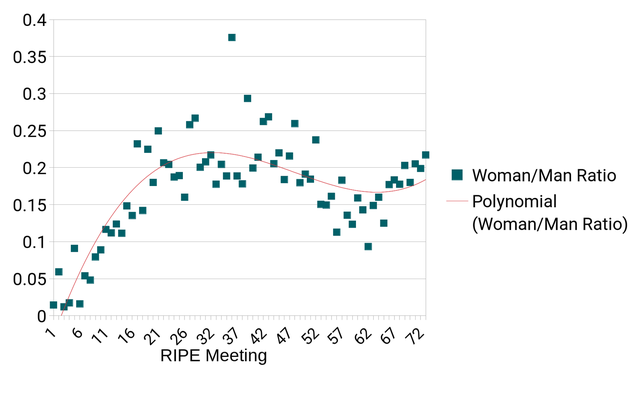
The second graph shows the ratio of women to men. If there were an equal number of women to men, as we would expect based on the population, we would see a 1:1 ratio. What we see is ratios ranging from 0.01 to 0.38... although that last one is an outlier, and comes from RIPE 36 which has an attendee list of especially dubious quality.
Overall this graph seems to show almost no real change in participation by women at RIPE over time. After the very early RIPE meetings - where very few women were present - we have seen basically no increase. Indeed, the most recent RIPE meetings saw women coming at the same rate as RIPE meetings more than 20 years ago. There has been a steady increase in the past 5 years or so, which may give us some hope that women feel welcome and want to join, but that leaves us now recovered from an apparent downward trend in the years before that.
The code for this is open source and on GitHub:
https://github.com/shane-kerr/ripemtggender
I'm happy to take pull requests or issue reports. I'm also happy to work with you if you want to apply a similar technique to some other meeting or other data set.
Ideas for More Data
Graphing meeting attendance does tell us something, but what other steps could be taken to get a better picture?
Better Visualisation
First, there are surely a lot of better ways to visualise even the simple data that we have now.
- Each of the meetings could have a dot which is sized based on the number of attendees; then you could easily see which meetings are more skewed than others.
- The meetings could be placed on a map with the gender ratios instead of chronologically. (This is similar to an idea suggested by at least one RIPE participant, which is to look at the gender ratios by country.
- Perhaps instead of adding up the number of women and men based on some probability, we could colour a square for each attendee based on the chance that the attendee is a woman or man, sort them, and then show a stack that way.
I am definitely not an expert in data visualisation - each graphic takes me ages and is inflexible. I certainly do not have good intuition about the "best" way to present information. But I'm happy to work with someone with interest in data visualisation to improve the situation!
Better RIPE Meeting Data
Another improvement with the existing technique will be using information that the RIPE NCC has gathered from attendees. As mentioned in the sidebar, future registrations may have a way for attendees to explicitly declare their gender.
The meeting registration software has asked for a title, like "Mr." or "Ms." for some time now. Something like 85% of attendees choose one, and this can give us a good guess as to the attendee gender. This information is not public, but the RIPE NCC may be able to provide it to researchers, or do analysis on their own.
Beyond Mere Presence
While attending a RIPE meeting is useful, it is only one way in which someone can participate in RIPE.
Within a RIPE meeting, there are presenters, panel participants, as well as people who speak at the microphone or in the online chat sessions. While no information is currently recorded about presenters, this can be determined by the name. Also, for more recent meetings we have video archives so one can have a quick look to see the gender of the presenter.
In addition to the RIPE meeting, RIPE has a number of leadership positions. This includes the RIPE working group chairs and the RIPE Programme Committee (PC). Certain RIPE NCC positions might also be considered part of the RIPE leadership, such as the RIPE NCC Executive Board, the RIPE NCC NRO NC, or the RIPE NCC Arbiters Panel. The membership list of each of these bodies is public, although tracking it over time is probably a non-trivial task.
On Beyond RIPE
While RIPE is the best networking community, there are other venues.
IETF
In 2013, the IETF had a big discussion about diversity. That resulted in a number of actions, including setting up a Diversity Design Team, creating a code of conduct, making sure that women are candidates for leadership roles, and allowing meeting participants to input their gender when registering for a meeting (although as far as I know the
statistics about meeting attendance are not public). Kathleen M. Moriarty wrote a blog post about the status last year.
In some senses the IETF is far ahead of the RIPE community when it comes to tackling diversity. However I would not yet consider the IETF truly diverse given how few women participate.
ICANN
Until this year, ICANN has not really dealt with how women joined in its meetings. While very sensitive to insuring that participation in ICANN is possible to people from all over the world and from many different stakeholder backgrounds (to use typical ICANN terminology), no attention was given to gender.
This came to a head after the ICANN 55 meeting in Marrakech, when a woman reported sexual harassment and found it very difficult to report; apparently in the prior 54 ICANN meetings not a single case of sexual harassment was reported. Keeping in mind that a typical ICANN meeting has something like 1,500 attendees, it seems strange that after 55 meetings this was the first problem, and to me it seems more likely that ICANN is simply blind to them.
Since ICANN 55, AFNIC published a nice report about ICANN diversity.
ICANN has revised its Expected Standards of Behavior document, and has kicked off the WS2 Diversity Subgroup. I see a lot of resistance to diversity work within ICANN. To me this is a sign that diversity work is badly needed there.
PyCon
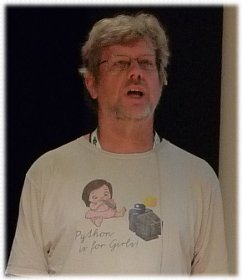
Increasing participation by women in PyCon has made the quality of the meeting better, not worse. This is exactly what we should expect to happen in RIPE meetings as well, if we are willing to work towards the goal.
Reactions
I gave my lightning talk during the first day of the RIPE meeting, and had a ton of conversations about the issue with people throughout the week. It also sparked off a short discussion on the RIPE mailing list.
While for the most part feedback was positive, I did notice a lot of concerns about any attempts by the RIPE PC to improve gender diversity. These concerns included:
- Fears that a quota system would be used: The idea that an arbitrary minimum number of presentations from women would be placed was upsetting to some people. Certainly the PC had not considered such an idea. While I cannot speak for future PC, I doubt that this would ever be done.
- Fears that presentation quality would suffer: Much like the quota system, the PC has never considered improving diversity at the cost of lowering quality. Also, this strikes me as incredibly sexist concern, because implicit is the idea that anything that women have to say is inherently of lower quality than what men have to say.
- Solving a non-problem: Some people worry that effort will be wasted solving something that is not really a problem. My hope is that measurements like the ones that I did can show that there actually is a problem. One might argue that the lack of women is not unique to RIPE but rather normal for technical professions; to me that just means that the problem is large, not that it does not exist.
- PC PC: That is, a "politically correct programme committee". There is concern that there is a wider movement in society towards controlling what we say or think, and that this political correctness is spilling over into RIPE.
Finally I should note that while women largely support the idea of increasing diversity in RIPE, this is by no means universal. Some women prefer to stay focused on the technical side of things, or are happy with the gender ratios as they are today.
Next Steps
The RIPE PC discussed the problems surrounding diversity during our regular face-to-face lunch during the last RIPE meeting, and I have been told this was also discussed at a similar meeting by the RIPE working group chairs. A small diversity task force was formed. I am serving in this group, and at the moment we are looking for advise from experts in this area since none of us are. We will report our findings and proposals as we go along.
If you are someone or know someone who you think would be able to advise us, please contact us (details below)!
If you are a woman and work in networking, please consider coming to a RIPE meeting. If you are a woman who is planning on attending a RIPE meeting, please consider submitting a talk, joining the PC, and otherwise making your ideas and your work more visible. There are tons of ways to help make this possible, and the diversity task force will be exploring lots of them.
Right now the work of getting more women involved with RIPE is just beginning. I look forward to a presentation at some future RIPE meeting where someone from the community explains how RIPE got to be the networking meeting that looks most like the people using the Internet.
How to Get in Touch
- You can contact the diversity task force on our mailing list at diversity@ripe.net
- You can contact me directly at shane@time-travellers.org
- And you can of course comment on this article below!

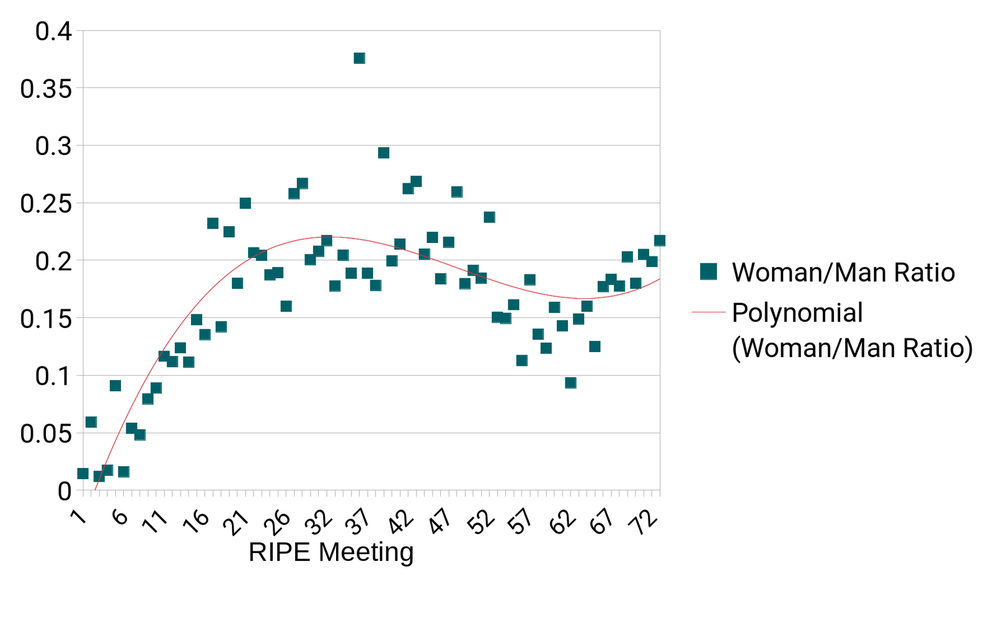


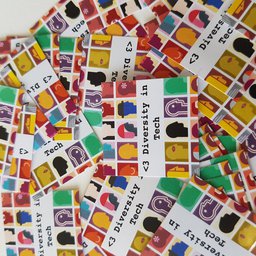

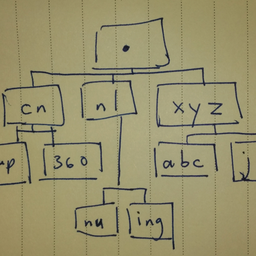
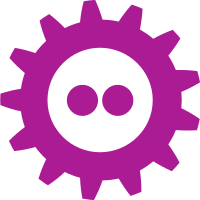
Comments 4
The comments section is closed for articles published more than a year ago. If you'd like to inform us of any issues, please contact us.
Raza Rizvi •
An interesting paper, and IMHO a worthy topic for research. Intelligence and the ability to contribute is not purely male phenomenon. Some might even say that it isn't that widespread in men anyway! Raza (Male)
Bill •
I think we can get better insights on the woman/man ratio of participation in RIPE events if it is compared against the woman/man ratio of graduates from relevant courses. Because if the pool of potential woman/man participants is fundamentally unequal, it's not that much a matter of RIPE policies but rather a matter of encouraging women to study computer science and engineering.
Mirjam Kühne •
Guido van Rossum sent me an email saying: "I'm glad you're taking up this subject. I like that you wrote up some of the negative responses you received -- I've seen those too, and I think it's pretty normal to see a range of responses. But that doesn't mean you can't make progress! We can't fix our biases if we're not aware of them, and sometime you have to start by over-compensating just to end up in the right place eventually."
Vesna Manojlovic •
I like the related article in Atlantic ("I Spent Two Years Trying to Fix the Gender Imbalance in My (STEM) Stories") from February 2018, and a quote: "Crucially, I tracked how I was doing in a simple spreadsheet. I can’t overstate the importance of that: It is a vaccine against self-delusion. It prevents me from wrongly believing that all is well." https://www.theatlantic.com/science/archive/2018/02/i-spent-two-years-trying-to-fix-the-gender-imbalance-in-my-stories/552404/